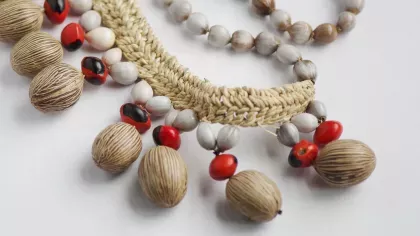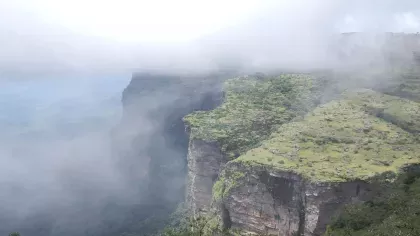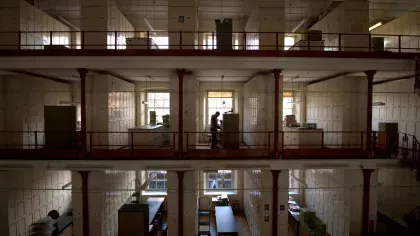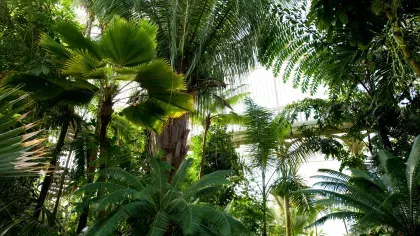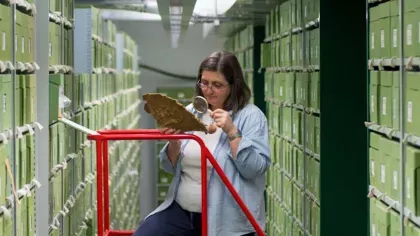Unpacking tapa: the science and culture of Pacific barkcloth
Mark Nesbitt, Research Leader for Economic Botany, reports on a major new research project using Kew’s historic collections.

Barkcloth: a neglected material
Today, clothing is made of woven fabrics worldwide. It is easy to forget that until 150 years ago barkcloth was the textile of choice in most of the tropics. Made of the inner bark of trees such as wild fig, barkcloth was a sustainably-produced, strong material laden with symbolic meaning. The arrival of cotton fabrics manufactured in Europe, and of missionaries keen to promote more ‘modest’ styles of dress, led to a steep decline in barkcloth use in areas such as South America, West Africa and parts of the Pacific.
Given the easy portability of barkcloth, which made it attractive to travellers collecting local crafts, and Kew’s history of research into useful plants, it is no surprise to find that our Economic Botany Collection contains around 100 pieces dating from the 1820s to 1930s. These include about 60 from the Pacific, where barkcloth is commonly known as tapa. Here the picture of current day use is complex: tapa production ended in islands such as Tahiti and Hawaii in the late 19th century, but has recently been revived, while production continues to flourish in Tonga, Fiji and Papua New Guinea.
Barkcloth is, as the name suggests, a plant-based material. In the Pacific, tapa cloth is made by beating the inner bark of trees such as paper mulberry (Broussonetia papyrifera) with wooden clubs. There is a huge amount of lost knowledge about the kinds of tree that can be used, dyes, and the range of oils and resins used to prepare surfaces. These are natural topics for Kew’s expertise, contributing to our understanding of which plants are used by humans, and why.
The appliance of science
In January 2016 a three-year investigation of tapa cloth began, funded by the Arts and Humanities Research Council. The project is a collaboration between Kew, the National Museum of Natural History (Smithsonian Institution), and the lead institution, the Centre for Textile Conservation and Technical Art History at the University of Glasgow. The project will systematically investigate the 1,000 pieces of tapa held by the three collaborators, with special attention to the plant materials used – both as dyes and fibres.
This work is particularly important for two user groups. For museum staff outside the Pacific, tapa is usually an unfamiliar material, despite being present in so many collections. As well as being hard to understand and explain to visitors, some tapa shows signs of severe physical degradation, and other pieces are so large they are difficult to store. For Pacific peoples, tapa collections such as that at Kew are reservoirs of traditional knowledge, often containing materials or styles that are no longer made. The results of the project will therefore highly relevant to contemporary makers and users of tapa in the Pacific.
The project brings together a wide range of expertise covering anthropology, history, museum conservation, and botany. We have employed three experienced researchers: Pacific art historian Andy Mills, conservation scientist Margaret Smith, and organics conservator Misa Tamura. We also have a wide range of collaborators ranging from specialists in isotopes, DNA and microscopy, to Pacific tapa makers whose expertise is essential to the project.
Delving into Kew’s collections
In April 2016 we had the first management meeting for the project. Among four days of meetings, we had quite a few hours of enjoyable tapa browsing. Even more rewarding than having one visiting expert is having twelve, as we did once our advisory board joined us. It is in disagreements and gaps in knowledge that one can identify new research questions. In fact many of the Kew pieces we looked at have puzzling features.
As it happens, all the pieces shown below come from one source, Prince Alfred, Duke of Edinburgh (1844-1900), Queen Victoria’s second son. In 1867-1869 he commanded HMS Galatea on a series of long voyages, touching down at Tahiti and Hawaii. Remarkably little is known about these voyages, or the wealth of objects (including tapa) brought back to London and distributed to museums. The fate of the HMS Galatea collections is being researched by Brittany Curtis at Kew for her Museum Studies MA.
This striking yellow tapa is labelled as from Hawaii, but is in fact from Tahiti. When unrolled, we could see the cloth is covered in red hand prints. This is a highly unusual feature. Could forensic science help us work out how many hands were involved? Both the identity of the fibres and dye, and the cultural import of the decoration remain to be established.
This large tiputa, or poncho, from Tahiti is one of six ‘robes’ brought back by Prince Alfred, three of which are still at Kew. Recent work by one of our advisory board, Caroline Cartwright, at the British Museum has found that the curly decorations on similar garments at the British Museum are made of Hibiscus tiliaceus bark, with other decorations made from the waxy covering of sugar cane stem.
Perhaps the greatest surprise was in several large sheets of tapa from Hawaii. These were stitched together at the edges, suggesting they were covers for sleeping. What was unusual was the thin, brittle feel of the tapa, suggestive of Japanese handmade paper and quite unlike other Hawaiian tapa. Is there a Japanese or industrial influence here?
Next steps
We finished the workshop with a much clearer sense of which of Kew’s tapa pieces would repay detailed investigation, and which are priorities for conservation and rehousing. The collaborations with other scientists are getting under way, and it is clear this project is going to lead to many publications, as well as a tapa database, and an exhibition at The Hunterian in Glasgow. Our advisory board is keen that we should increase Pacific community engagement in the project, and that will be a priority over the next year. It is a great opportunity to have a team of this size and calibre studying the collections in Kew and Glasgow, and I can’t wait to see what we find out.
